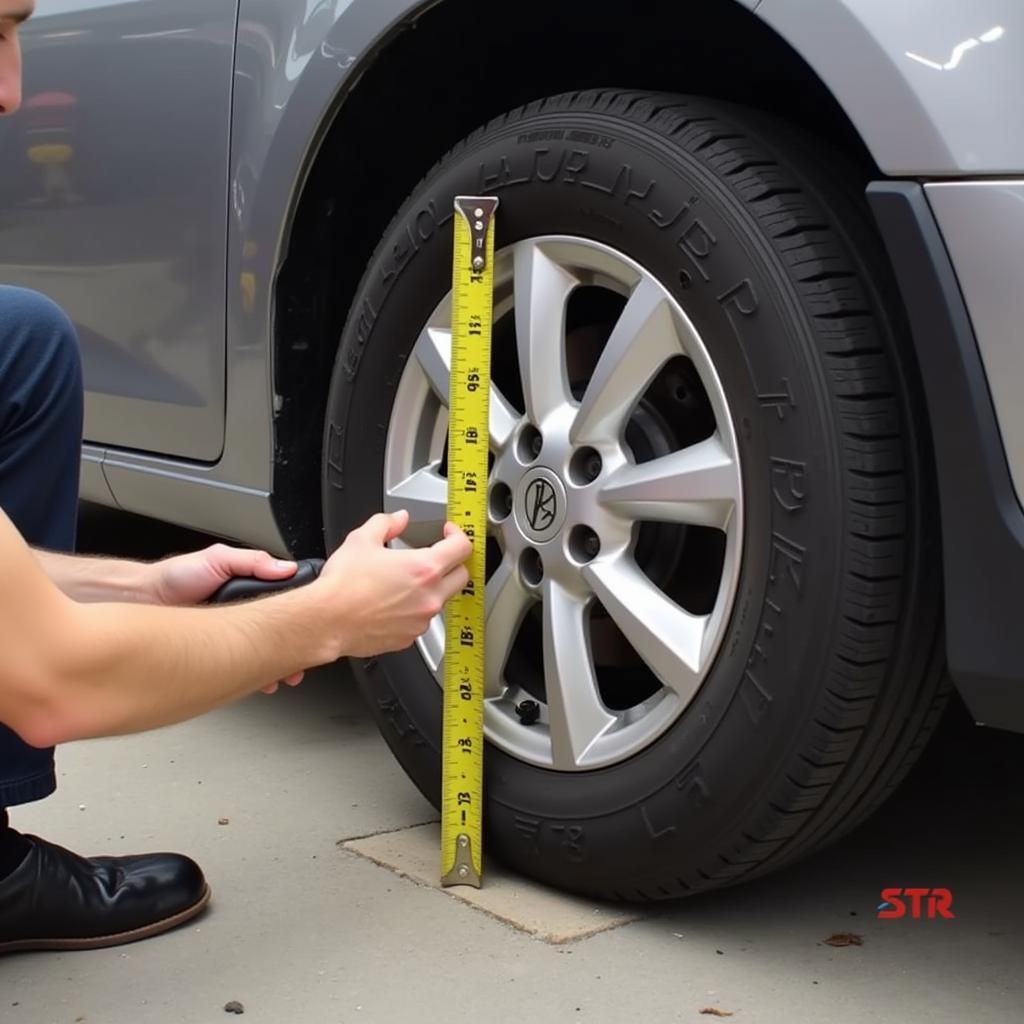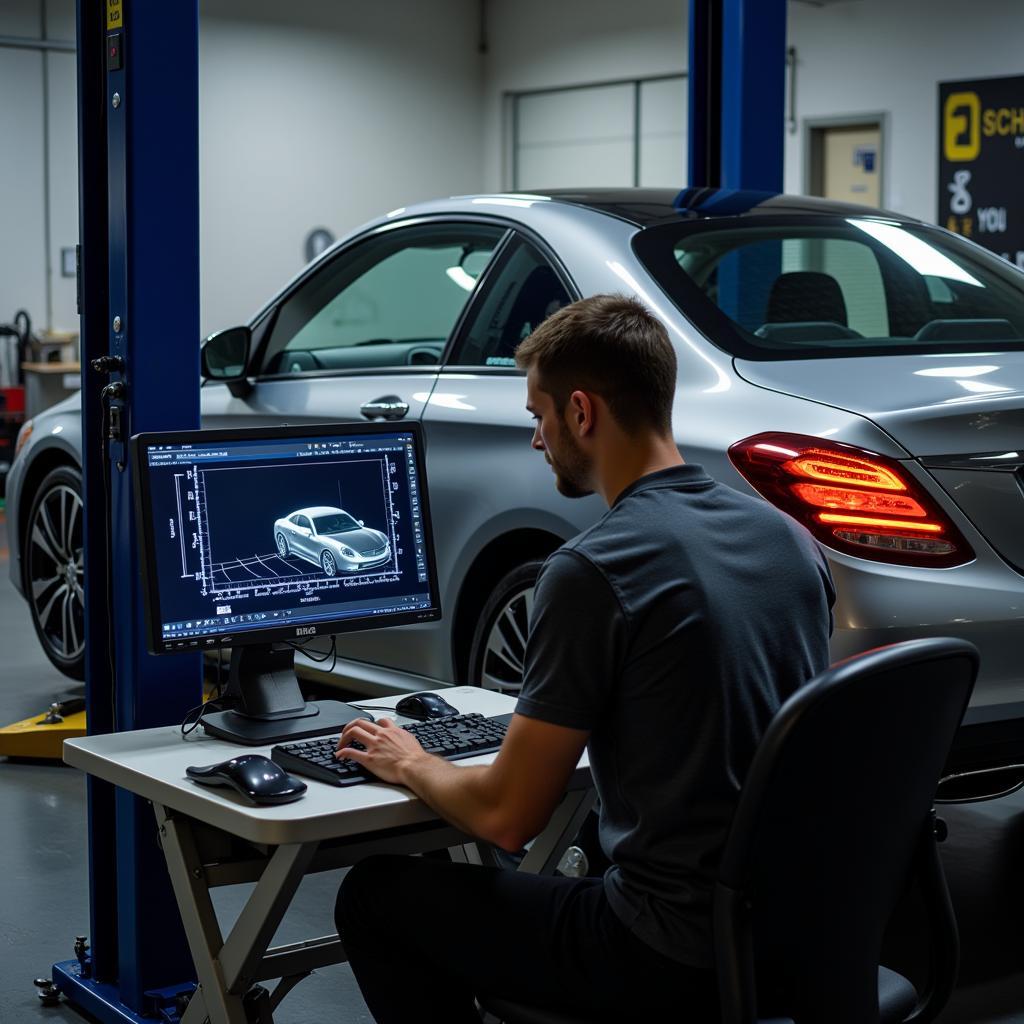Getting your car’s alignment fixed is crucial for safe and efficient driving. A misaligned car can lead to uneven tire wear, reduced fuel economy, and even difficulty controlling the vehicle. This comprehensive guide will walk you through the signs of misalignment, the different types of alignment, and how to fix your car’s alignment, whether you’re a DIY enthusiast or prefer to leave it to the professionals.
 Checking Car Wheel Alignment at Home
Checking Car Wheel Alignment at Home
Misaligned wheels can make your car pull to one side, wear out your tires prematurely, and even affect your fuel efficiency. If you notice your car isn’t handling quite right, it might be time to learn how to fix your car’s alignment. First, let’s discuss the signs of a misaligned car.
Recognizing the Signs of Misalignment
Several telltale signs indicate your car’s alignment is off. These include:
- Pulling to one side: If your car consistently drifts to the left or right, even on a straight road, your alignment likely needs attention.
- Uneven tire wear: Inspect your tires regularly. If one side of a tire wears out faster than the other, it points towards misalignment.
- Crooked steering wheel: When driving straight, your steering wheel should be centered. If it’s off-center, your alignment is likely the culprit.
- Squealing tires: While squealing tires can be caused by various factors, misalignment is a common one.
If you experience how to fix a crooked car tire, it’s a clear sign you might need a wheel alignment.
Understanding Different Types of Alignment
There are three main types of wheel alignment:
- Toe: This refers to the angle of the front wheels inward or outward when viewed from above.
- Camber: This is the inward or outward tilt of the tires when viewed from the front.
- Caster: Caster is the angle of the steering axis when viewed from the side. It affects steering stability.
Each of these angles plays a crucial role in how your car handles and wears its tires.
How to Fix Your Car’s Alignment: DIY vs. Professional
While some minor adjustments can be attempted at home, fixing a car’s alignment generally requires specialized equipment and expertise.
DIY Alignment Checks and Adjustments
- Check tire pressure: Ensure all tires are inflated to the recommended pressure. Uneven tire pressure can mimic alignment issues. You can often find this information in your car’s manual or on a sticker inside the driver’s side doorjamb.
- Visual inspection: Look for any obvious signs of damage to suspension components. If you spot something concerning, you’ll need professional help.
- Basic toe adjustment: If you’re mechanically inclined, you can attempt a basic toe adjustment using a tape measure and the adjustment tie rods under your car. However, this is a delicate procedure, and if done incorrectly can worsen the problem.
If you need to fix car trunk seal or fix bent axle car, it’s best left to the professionals due to safety concerns.
Professional Alignment Service
Taking your car to a qualified mechanic is the most reliable way to fix your car’s alignment. They possess the necessary equipment and expertise to diagnose and correct alignment issues accurately. A professional alignment typically involves:
- Inspection: A thorough inspection of your suspension and steering components.
- Measurement: Using an alignment machine to measure the current alignment angles.
- Adjustment: Adjusting the alignment angles to the manufacturer’s specifications.
- Road test: A final road test to verify the alignment is correct.
“A proper wheel alignment not only saves you money on tires but also ensures a safer and more enjoyable driving experience,” says John Smith, Automotive Engineer at Smith Automotive Solutions.
 Professional Car Alignment Service
Professional Car Alignment Service
How Much Does an Alignment Cost?
The cost of a wheel alignment varies depending on the shop and your car’s make and model. However, you can expect to pay between $75 and $200. If you are looking into how much is it to get a car horn fixed, it can range from a simple DIY fix to a more complex repair depending on the issue. Considering car seat covers to fix a 2003 lincoln ls, it’s a cost-effective way to refresh the interior.
Conclusion
Knowing how to fix your car’s alignment, or at least recognizing when it needs attention, is vital for maintaining your car’s performance, safety, and longevity. Ignoring alignment issues can lead to costly repairs down the road. While DIY checks can be helpful, professional alignment is the recommended course of action for accurate and effective results. Contact AutoTipPro at +1 (641) 206-8880 or visit our office at 500 N St Mary’s St, San Antonio, TX 78205, United States, for expert assistance and to schedule your car’s alignment service.
FAQ
-
How often should I get my car’s alignment checked? It’s a good idea to have your alignment checked annually or every 12,000 miles, or sooner if you notice any signs of misalignment.
-
Can potholes cause misalignment? Yes, hitting a pothole or curb can knock your car’s alignment out of whack.
-
Will a new set of tires fix alignment issues? No, new tires will not fix underlying alignment problems. In fact, misalignment will cause new tires to wear unevenly just like the old ones.
-
Can I drive with a misaligned car? While you can technically drive with a misaligned car, it’s not recommended. It can be unsafe, and it will accelerate tire wear.
-
What is the difference between wheel balancing and alignment? Wheel balancing corrects for weight imbalances in the tire and wheel assembly, while alignment deals with the angles of the wheels.
-
How long does a wheel alignment take? A professional wheel alignment typically takes about an hour.
-
What are the benefits of a proper wheel alignment? Proper wheel alignment improves handling, extends tire life, enhances fuel efficiency, and increases overall driving safety.




Leave a Reply